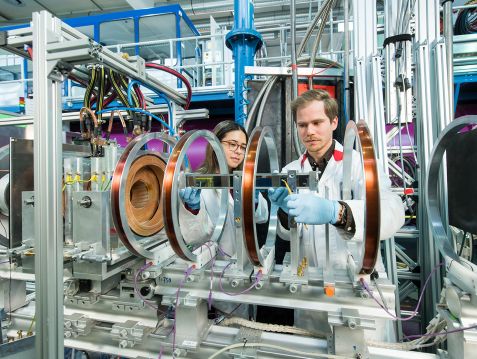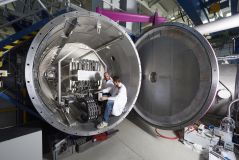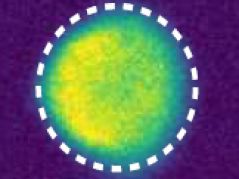MLZ is a cooperation between:
 > Technische Universität München
> Technische Universität München > Helmholtz-Zentrum Hereon
> Helmholtz-Zentrum Hereon
 > Forschungszentrum Jülich
> Forschungszentrum Jülich
MLZ is a member of:
 > LENS
> LENS > ERF-AISBL
> ERF-AISBL
MLZ on social media:

MLZ (eng)
Lichtenbergstr.1
85748 Garching
13.03.2020
Vortex around frozen magnets
Soup freezes at sub-zero temperatures, by forming small islands of ice germs first. Magnetic structures, so-called skyrmions, behave very similarly, as scientists have discovered with the help of neutrons for the first time at the MLZ.
Skyrmions, discovered for the first time at the FRM II, are vortices of the magnetization, which run like tubes through a magnetic material. They behave like particles and are only formed at very low temperatures. How exactly this happens cannot yet be explained. In order to get to the bottom of this, scientists of the physics department of the Technical University of Munich have combined different measuring methods at the MLZ in an elaborate investigation.
Islands of vortices
Manganese silicon (MnSi) is the material of choice for skyrmions, because they have already been found there in large numbers at low temperatures. But how do skyrmions form during freezing? In order to answer this question, the team first measured the magnetizability of the material in the transition region. From this, the physicists concluded that, like ice nuclei in freezing water, there might be islands of developing skyrmion nuclei. This means that areas of skyrmions are already formed locally in the transition phase. They wanted to take a closer look at this, which is why the samples migrated to FRM II.
Germs form and disappear again
Using the small-angle scattering at the SANS 1 instrument, the scientists were able to determine the size of the nuclei to be approximately 1000 times the size of a silicon atom. In addition, the measurement results indicate that the nuclei in the transition region are formed for a short time and then disappear again until they finally crystallize into the skyrmion phase under suitable conditions. To support this assumption, the scientists placed the samples in the beam of the RESEDA, also at the Heinz Maier-Leibnitz Zentrum. At RESEDA they showed that this transition phase lasts one nanosecond. Finally, microwave rays confirmed that they were indeed skyrmion nuclei.
Neutrons support the conjectures
Taken together, the measurements reveal something very important to the scientists: The crystallization not only reminds of that of ice in water, but also of liquid crystals and can be described with the same theory. Liquid crystals, on the other hand, are not only common and well understood among physicists; they are also used in LCD screens, for example.
“Only the combination of all these measuring methods could lead us to this result. The neutrons were crucial for this and supported our assumptions in the end”, says Dr. Christian Franz, instrument scientist at RESEDA and co-author of the publication.
With the right theory at hand, the scientists can face further investigations. For example, it is not yet clear whether the results also apply to the entire class of materials with the same crystal structure, or whether a new classification is necessary. But it is also important for possible applications in data storage to understand the formation and destruction processes of skyrmions.
Original publication:
J. Kindervater, I. Stasinopoulos, A. Bauer, F. X. Haslbeck, F. Rucker, A. Chacon, S. Mühlbauer, C. Franz, M. Garst, D. Grundler, and C. Pfleiderer, Weak Crystallization of Fluctuating Skyrmion Textures in MnSi, Phys. Rev. X 9, 041059, DOI: https://doi.org/10.1103/PhysRevX.9.041059
Related News
-
11.07.2018
Magnetic vortices: twice as interesting
MLZ is a cooperation between:
 > Technische Universität München
> Technische Universität München > Helmholtz-Zentrum Hereon
> Helmholtz-Zentrum Hereon
 > Forschungszentrum Jülich
> Forschungszentrum Jülich
MLZ is a member of:
 > LENS
> LENS > ERF-AISBL
> ERF-AISBL
MLZ on social media:





